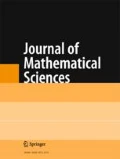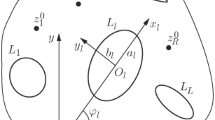We investigate the stress-strain state of an infinite isotropic plate with a crack the faces of which are free of external loading. The plate is under the action of concentrated bending moments. It is assumed that the crack faces are in a smooth contact along the entire length of the crack in the two-dimensional zone of constant width near the upper base of the plate. As a result of the contact of the crack faces, a solution of the problem is presented in the form of solutions of two related problems: a plane problem of the theory of elasticity and a problem of bending of plates using the Reissner theory. Using methods of the theory of functions of complex variable and complex potentials, we obtain a system of singular integral equations and numerically solved this system by the method of mechanical quadratures. In the case of geometric and physical symmetry of the problem with respect to the crack, we perform the numerical analysis of a solution of the problem and plot graphic dependences of the contact force between the faces of the crack and moment intensity factors for different parameters of the problem.
Similar content being viewed by others
References
L. T. Berezhnitskii, M. V. Delyavskii, and V. V. Panasyuk, Bending of Thin Plates with Defects of the Crack Type [in Russian], Naukova Dumka, Kiev (1979).
L. P. Mazurak and L. T. Berezhnitskii, Bending of Transversally Isotropic Plates with Crack-Type Defects [in Russian], Naukova Dumka, Kiev (1990).
N. I. Muskhelishvili, Some Basic Problems of the Mathematical Theory of Elasticity. Basic Equations. Plane Theory of Elasticity. Torsion and Bending [in Russian], Nauka, Moscow (1966).
N. I. Muskhelishvili, Singular Integral Equations. Boundary-Value Problems of the Theory of Functions and Several Their Application in Mathematical Physics [in Russian], Nauka, Moscow (1968).
V. K. Opanosovych, “Bending of a plate with a through-the-thickness rectilinear crack with regard for the width of the domain of contact of its surfaces,” Nauk. Notat. Luts’k. Tekhn. Univ., Issue 20 (2), 123–127 (2007).
V. K. Opanosovych, “Singular integral equations of the problem of bending of a plate with crack according to the Reissner theory,” in: Proceeding of the Shevchenko Scientific Society, Vol. VI, Materials Science and Mechanics of Materials [in Ukrainian], Lviv (2001), pp. 120–125.
V. K. Opanosovych, M. V. Delyavs’kyi, and A. Podhorecki, “A new approach to the calculation of the stressed state of a plate with crack according to the Reissner theory,” in: V. V. Panasyuk (editor), Fracture Mechanics and Strength of Materials, Vol. 2, Analytic Methods in Fracture Mechanics of Materials [in Ukrainian], Naukova Dumka, Kiev (1999), pp. 186–189.
V. K. Opanosovych, V. P. Novosad, and R. H. Seliverstov, “Taking account of the contact of the faces of a crack in the course of bending of a transversally isotropic plate,” in: Collection of Scientific Works "Mechanics and Physics of Fracture of Building Materials and Structures [in Ukrainian], Issue 5, Kamenyar, Lviv (2002), pp. 148–153.
V. Opanosovych and I. Yatsyk, “Bending of a Reissner plate with a through-the-thickness crack with regard for the width of the domain of contact of its faces,” Visn. Lviv. Univ., Ser. Mekh.-Mat., Issue 69, 125–135 (2008).
V. V. Panasyuk, M. P. Savruk, and A. P. Datsyshyn, Distribution of Stresses Near Cracks in Plates and Shells [in Russian], Naukova Dumka, Kiev (1976).
I. A. Prusov, Conjugation Method in the Theory of Plates [in Russian], Byelorussian University, Minsk (1975).
M. P. Savruk, Two-Dimensional Problems of Elasticity for Bodies with Cracks [in Russian], Naukova Dumka, Kiev (1981).
M. Abramowitz and I. A. Stegun (editors), Handbook of Mathematical Functions with Formulas, Graphs and Mathematical Tables, National Bureau of Standards, Appl. Math., Ser. 55 (1964).
S. P. Timoshenko and S. Woinovsky-Krieger, Theory of Plates and Shells, McGraw-Hill, New York (1959).
I. P. Shats’kii, “Bending of a plate weakened by a cut with contacting faces,” Dop. Akad. Nauk Ukr. RSR, Ser. A, Fiz.-Mat. Tekhn. Nauk., No. 7, 49–51 (1988).
I. P. Shats’kii and V. V. Perepichka, “Bending of a semiinfinite plate weakened by a crack with contacting edges,” Fiz.-Khim. Mekh. Mater., 28, No. 2, 54–58 (1992); English translation: Mater. Sci., 28, No. 2, 154–157 (1993).
I. Shats’kii, V. Perepichka, T. Dalyak, and A. Shcherbii, “Problems of the theory of plates and shells with interconnected boundary conditions on cuts,” in: Mathematical Problems of Mechanics of Inhomogeneous Structures [in Ukrainian], Vol. 2, Lviv (2000), pp. 51–54.
R. S. Alwar and K. N. Ramachandran Nambissan, “Influence of crack closure on the stress intensity factor for plates subjected to bending – A 3-D finite element analysis,” Eng. Fracture Mech., 17, No. 4, 323–333 (1983).
I. Benedetti, M. H. Aliabadi, and G. Davi, “A fast 3D dual boundary element method based on hierarchical matrices,” Int. J. Solids Struct., 45, No. 7–8, 2355–2376 (2008).
J. P. Dempsey, I. I. Shekhtman, and L. I. Slepyan, “Closure of a through crack in a plate under bending,” Int. J. Solids Struct., 35, No. 31–32, 4077–4089 (1998).
T. Dirgantara and M. H. Aliabadi, “Stress intensity factors for cracks in thin plates,” Eng. Fracture Mech., 69, 1465–1486 (2002).
S. Guimaraes and J. C. F. Telles, “The method of fundamental solutions for fracture mechanics—Reissner’s plate application,” Eng. Anal. Bound. Elem., 33, No. 10, 1152–1160 (2009).
F. S. Heming, Jr., “Sixth order analysis of crack closure in bending of an elastic plate,” Int. J. Fracture, 16, No. 4, 289–304 (1980).
D. P. Jones and J. L. Swedlow, “The influence of crack closure and elasto-plastic flow on the bending of a cracked plate,” Int. J. Fracture, 11, No. 6, 897–914 (1975).
Y. W. Kwon, “Finite element analysis of crack closure in plate bending,” Comput. Struct., 32, No. 6, 1439–1445 (1989).
B. Litewka and R. Sygulski, “Application of the fundamental solutions by Ganowicz in a static analysis of Reissner’s plates by the boundary element method,” Eng. Anal. Bound. Elem., 34, No. 12, 1072–1081 (2010).
P. H. Wen and M. H. Aliabadi, “A variational approach for evaluation of stress intensity factors using the element free Galerkin method,” Int. J. Solids Struct., 48, No. 7–8, 1171–1179 (2011).
M. L. Williams, “The bending stress distribution at the base of a stationary crack,” Trans ASME. J. Appl. Mech., 28, 78–82 (1961).
M. J. Young and C. T. Sun, “Influence of crack closure on the stress intensity factor in bending plates – A classical plate solution,” Int. J. Fracture, 55, 81–93 (1992).
Author information
Authors and Affiliations
Additional information
Translated from Matematychni Metody ta Fizyko-Mekhanichni Polya, Vol. 54, No. 4, pp. 71–81, October–December, 2011.
Rights and permissions
About this article
Cite this article
Opanasovych, V.K., Yatsyk, I.M. & Sulym, H.T. Bending of Reissner’s plate containing a through-the-thickness crack by concentrated moments taking into account the width of a contact zone of its faces. J Math Sci 187, 620–634 (2012). https://doi.org/10.1007/s10958-012-1088-5
Received:
Published:
Issue Date:
DOI: https://doi.org/10.1007/s10958-012-1088-5




